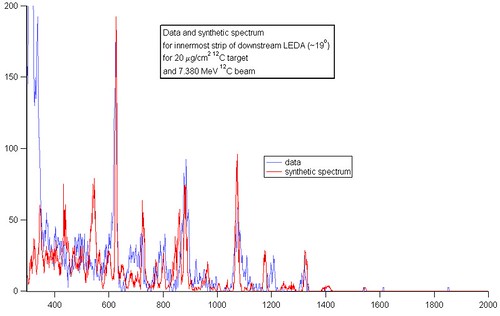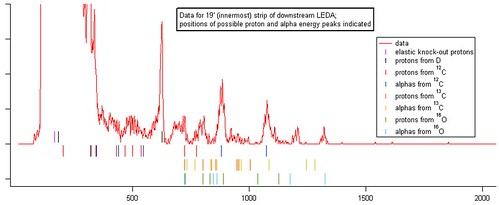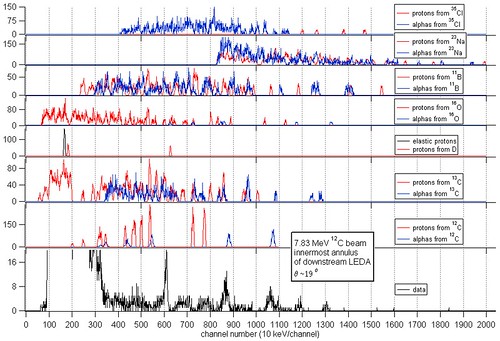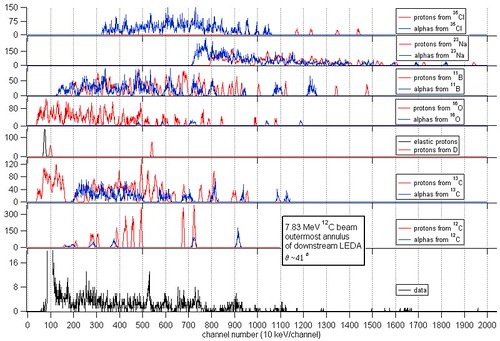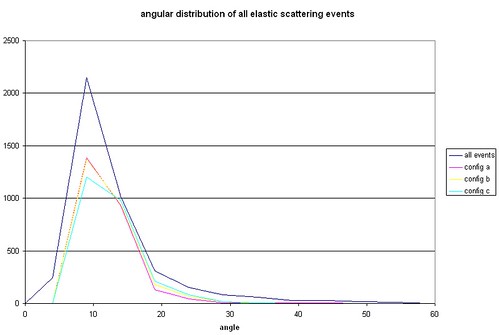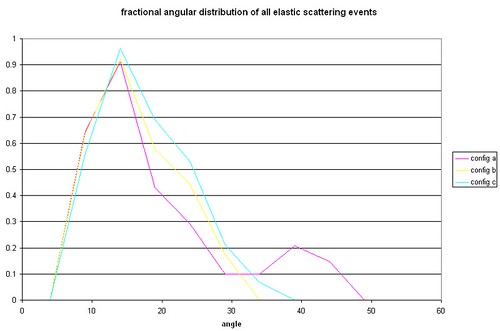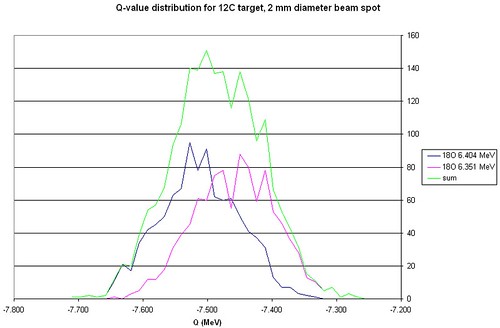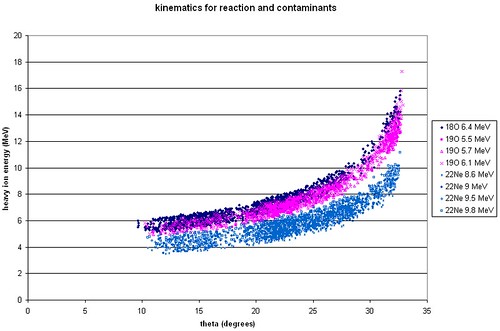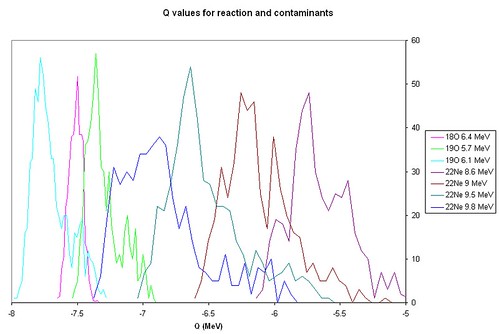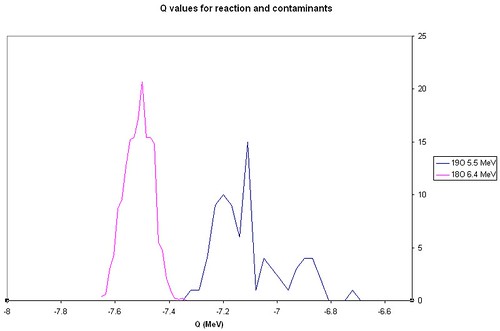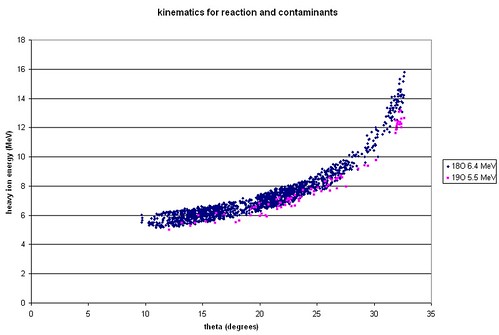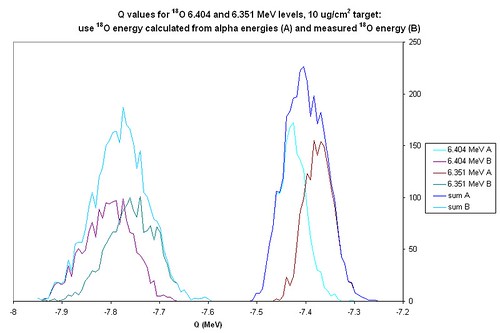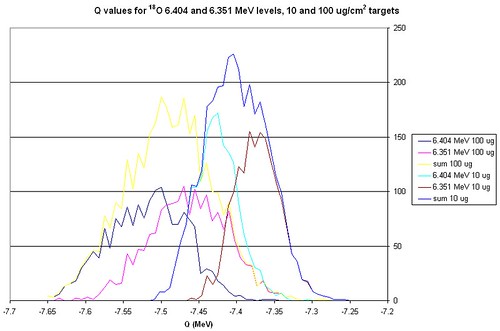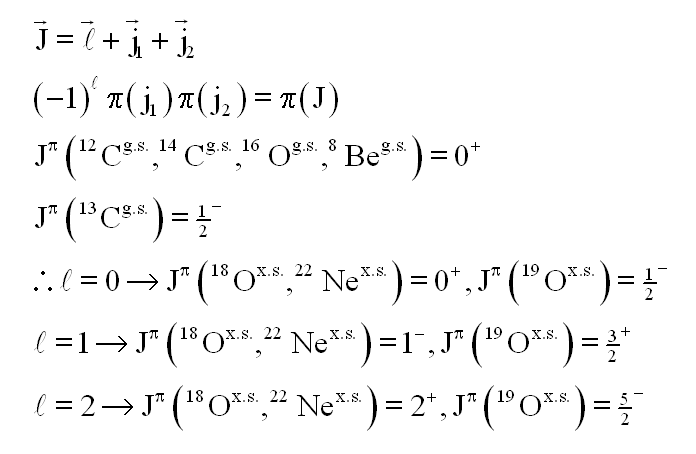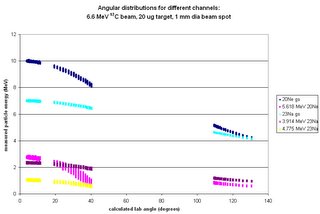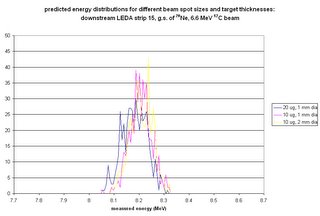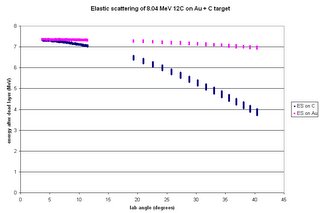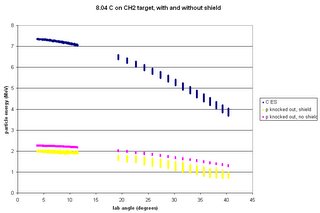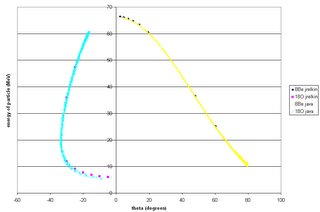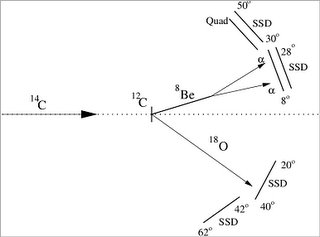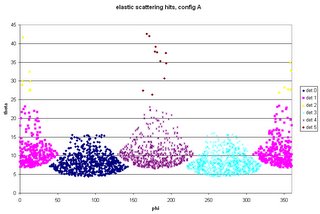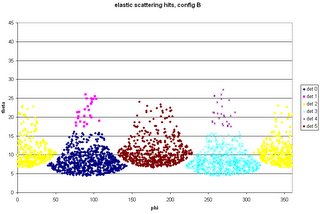Goal: do simulations that give as output synthetic energy spectra for given strips of the current detector assembly. (I'd provide details of how the code produces the spectra, but Blogger keeps thinking that the java code is instructions on how to format the entry.) The code now cycles through all given excitation energies for a single reaction before producing two output files: one with all of the information and diagnostics for each event, and one with the combined energy hits in each strip for all excitation energies for that reaction.
Use the following inputs:
beam energy: 7.83 MeV
target: 20 μg/cm
2 C (for energy loss purposes)
Reactions considered, with excitation energies of residual nucleus that result in outgoing particle energies between 1 and 20 MeV at 20':
12C(
12C,p)
23Na (0-5.7 MeV)
12C(
13C,p)
24Na (0-8)
12C(
16O,p)
27Al (0-9)
12C(
11B,p)
22Ne (0-12.7)
12C(
23Na,p)
34S (0-17.6)
12C(
35Cl,p)
46Ti (0-13)
12C(p,p)
12C (0)
12C(d,p)
13C (0-3.3)
12C(
12C,α)
20Ne (0-7)
12C(
13C,α)
21Ne (0-10)
12C(
16O,α)
24Mg (0-10)
12C(
11B,α)
19F (0-10)
12C(
23Na,α)
31P (0-17)
12C(
35Cl,α)
43Sc (0-10)
Actual excitation energies used:
23Na {0, 0.44, 2.076, 2.3907, 2.63986, 2.704, 2.982, 3.6776, 3.848, 3.914, 4.42963, 4.775}
24Na {0, 0.472207, 0.5632, 1.34143, 1.34465, 1.34663, 1.5124, 1.84601, 1.88551, 2.51351, 2.5628, 2.90394, 2.97783, 3.2167, 3.37184, 3.41325, 3.58926, 3.62825, 3.65597, 3.68179, 3.74509, 3.896, 3.9357, 3.94339, 3.97732, 4.04849, 4.145, 4.1868, 4.1963, 4.20719, 4.22, 4.44154, 4.459, 4.526, 4.56206, 4.6215, 4.6922, 4.75094, 4.772, 4.89135, 4.9394, 4.98, 5.03, 5.0449, 5.05972, 5.11741, 5.16, 5.19244, 5.25, 5.33906, 5.39719, 5.432, 5.47896, 5.585, 5.6284, 5.66, 5.72, 5.774, 5.80966, 5.8629, 5.91846, 5.95316, 5.9662, 6.07283, 6.2224, 6.24762, 6.578, 6.96221, 6.96678, 6.99337, 7.01029, 7.0685, 7.072, 7.0858, 7.0966, 7.1416, 7.1513, 7.1631, 7.1862, 7.187, 7.1923, 7.2456, 7.2461, 7.2518, 7.3244, 7.3276, 7.3367, 7.3727, 7.3863, 7.4255, 7.4337, 7.4461, 7.4739, 7.4998, 7.5113, 7.519, 7.5323, 7.533, 7.6274, 7.6555, 7.708, 7.832, 7.903}
27Al {0, 0.84376, 2.21201, 2.7349, 2.982, 3.0042, 3.6804, 3.9568, 4.0546, 4.4102, 4.5103, 4.58, 4.8116, 5.1556, 5.248, 5.4199, 5.4328, 5.4384, 5.4998, 5.5509, 5.6673, 5.7516, 5.827, 5.9603, 6.0808, 6.1158, 6.1584, 6.2847, 6.4628, 6.4773, 6.5122, 6.533, 6.6051, 6.6513, 6.713, 6.765, 6.7763, 6.8138, 6.8207, 6.9479, 6.9929, 6.996, 7.0713, 7.1736, 7.2272, 7.28, 7.289, 7.4, 7.413, 7.443, 7.4771, 7.55, 7.578, 7.66, 7.6765, 7.679, 7.721, 7.798, 7.806, 7.858, 7.9, 7.935, 7.948, 7.997, 8.037, 8.043, 8.065, 8.097, 8.13, 8.136, 8.1821, 8.287, 8.324, 8.361, 8.376, 8.396, 8.408, 8.4207, 8.442, 8.4903, 8.521, 8.537, 8.553, 8.586, 8.5976, 8.675, 8.693, 8.7087, 8.7166, 8.7322, 8.7536, 8.7742, 8.804, 8.825, 8.861, 8.8972, 8.905, 8.9092, 8.952, 8.9634, 9.001}
22Ne {0, 1.274542, 3.3582, 4.4563, 5.1463, 5.329, 5.3634, 5.5237, 5.6414, 5.9099, 6.1199, 6.235, 6.3111, 6.3452, 6.6358, 6.691, 6.8194, 6.8535, 6.9, 7.051, 7.3411, 7.3437, 7.4059, 7.423, 7.469, 7.489, 7.6431, 7.664, 7.722, 7.921, 8.0769, 8.1343, 8.1622, 8.3759, 8.4896, 8.5614, 8.596, 8.741, 8.8553, 8.9003, 8.976, 9.045, 9.097, 9.178, 9.1781, 9.229, 9.25, 9.324, 9.508, 9.541, 9.652, 9.725, 9.842, 10.066, 10.137, 10.2089, 10.2808, 10.2953, 10.384, 10.423, 10.469, 10.4933, 10.618, 10.696, 10.706, 10.751, 10.858, 10.922, 11.032, 11.13, 11.195, 11.271, 11.433, 11.466, 11.52}
34S {0, 2.127564, 3.304212, 3.91641, 4.074667, 4.11481, 4.624404, 4.68898, 4.87684, 4.88976, 5.22818, 5.32251, 5.38099, 5.679927, 5.689, 5.75588, 5.84753, 5.9981, 6.12148, 6.16886, 6.25122, 6.25168, 6.34249, 6.42142, 6.42812, 6.47877, 6.535, 6.639, 6.68533, 6.729, 6.742, 6.82882, 6.84791, 6.8637, 6.89, 6.95422, 7.11045, 7.16446, 7.21928, 7.24805, 7.27, 7.36742, 7.392, 7.46772, 7.55269, 7.62991, 7.657, 7.714, 7.73079, 7.753, 7.78122, 7.788, 7.795, 7.97472, 8.02, 8.0363, 8.083, 8.1381, 8.1751, 8.18546, 8.2054, 8.255, 8.264, 8.293, 8.29439, 8.369, 8.3854, 8.425, 8.502, 8.50677, 8.61574, 8.651, 8.657, 8.67, 8.70235, 8.712, 8.72763, 8.733, 8.782, 8.8057, 8.87402, 8.876, 8.942, 8.968, 8.99, 9.02631, 9.095, 9.15871, 9.20804, 9.478, 9.54609, 9.59841, 9.64, 9.66574, 9.711, 9.80188, 9.8367, 9.86, 9.93335, 9.981, 10.09221, 10.097, 10.142, 10.17, 10.17, 10.17959, 10.201, 10.21215, 10.237, 10.25, 10.31153, 10.386, 10.407, 10.447, 10.494, 10.529, 10.587, 10.617, 10.626, 10.6501, 10.663, 10.67, 10.705, 10.768, 10.791, 10.803, 10.84062, 10.869, 10.895, 10.916, 10.931, 10.994, 11.015, 11.02494}
46Ti {0, 0.889286, 2.009846, 2.611, 2.9618, 3.05846, 3.168, 3.213, 3.2173, 3.2357, 3.29886, 3.338, 3.44139, 3.5531, 3.5693, 3.5717, 3.5798, 3.6102, 3.677, 3.696, 3.7238, 3.731, 3.7379, 3.7715, 3.82643, 3.845, 3.848, 3.85244, 3.856, 3.872, 3.8893, 3.9056, 3.926, 3.9419, 4.0031, 4.0253, 4.0388, 4.1301, 4.1787, 4.1915, 4.3158, 4.3226, 4.372, 4.398, 4.4171, 4.437, 4.5, 4.5234, 4.527, 4.573, 4.617, 4.6623, 4.675, 4.697, 4.7264, 4.791, 4.8272, 4.845, 4.8969, 4.95, 5, 5.0237, 5.079, 5.094, 5.117, 5.154, 5.18, 5.1976, 5.206, 5.23, 5.28, 5.321, 5.361, 5.363, 5.409, 5.515, 5.53, 5.604, 5.61, 5.7, 5.794, 5.811, 5.828, 5.84, 5.872, 5.903, 5.95, 5.965, 5.992, 6.021, 6.025, 6.094, 6.118, 6.134, 6.1505, 6.2004, 6.217, 6.2419, 6.251, 6.266, 6.305, 6.338, 6.36, 6.395, 6.398, 6.424, 6.458, 6.513, 6.55, 6.574, 6.616, 6.685, 6.739, 6.794, 6.8303, 6.851, 6.89, 6.958, 6.974, 7.019, 7.041, 7.101, 7.12, 7.147, 7.172, 7.18, 7.201, 7.238, 7.288, 7.312, 7.35, 7.392, 7.41, 7.429, 7.472, 7.534, 7.558, 7.584, 7.608, 7.63, 7.66, 7.71, 7.73, 7.735, 7.788, 7.849, 7.874, 7.917, 7.937, 7.9418, 7.9608, 7.979, 8.013, 8.02, 8.04, 8.088, 8.134, 8.182, 8.2175, 8.23, 8.2839, 8.293, 8.346, 8.384, 8.46, 8.467, 8.53, 8.574, 8.621, 8.662, 8.701, 8.7162, 8.761, 8.808, 8.86, 8.94, 8.984, 9, 9.07, 9.111, 9.141, 9.168, 9.17, 9.205, 9.253, 9.304, 9.345, 9.399, 9.42, 9.426, 9.474, 9.519, 9.55, 9.572, 9.615, 9.649, 9.67, 9.682, 9.718, 9.761, 9.77, 9.79, 9.852, 9.864, 9.87, 9.973, 10, 10.038, 10.0416, 10.18, 10.212, 10.256, 10.321, 10.347, 10.35, 10.374, 10.38, 10.441, 10.523, 10.602, 10.661, 10.73, 10.782, 10.866, 10.938, 10.98, 11.05, 11.051, 11.11, 11.167, 11.299, 11.354, 11.3742, 11.426, 11.45, 11.57, 11.698, 11.84, 12.2, 12.46, 12.65, 12.974}
12C {0}
13C {0.0,3.089}
20Ne {0, 1.633674, 4.2477, 4.96651, 5.6214, 5.7877}
21Ne {0, 0.350727, 1.745911, 2.78823, 2.79416, 2.8666, 3.66264, 3.73559, 3.88396, 4.4318, 4.52586, 4.68456, 4.72534, 5.3352, 5.4318, 5.5498, 5.6308, 5.68977, 5.7737, 5.8187, 5.8209, 5.99261, 6.0333, 6.1752, 6.2603, 6.2667, 6.4119, 6.4483, 6.5435, 6.5542, 6.6077, 6.6398, 6.7493, 6.857, 6.9005, 7.0067, 7.0226, 7.0421, 7.109, 7.154, 7.211, 7.226, 7.294, 7.32, 7.3569, 7.4228, 7.465, 7.547, 7.6, 7.627, 7.6491, 7.74, 7.81, 7.9603, 7.979, 7.9821, 8.008, 8.062, 8.1549, 8.2222, 8.2412, 8.287, 8.303, 8.36, 8.402, 8.43, 8.465, 8.522, 8.591, 8.6645, 8.68, 8.782, 8.801, 8.849, 8.8592, 8.93, 8.991, 9.077, 9.1489, 9.188, 9.251, 9.282, 9.367, 9.402, 9.475, 9.637, 9.7, 9.8591, 9.9436, 9.963}
24Mg {0, 1.368675, 4.122874, 4.23836, 5.2352, 6.01032, 6.4325, 7.34905, 7.5553, 7.61647, 7.7477, 7.8122, 8.113, 8.3581, 8.4384, 8.4393, 8.6549, 8.8645, 9.0035, 9.1462, 9.2844, 9.2998, 9.30095, 9.3054, 9.4578, 9.51621, 9.528, 9.5327, 9.8284, 9.9678}
19F {0, 0.109894, 0.197143, 1.34567, 1.4587, 1.554038, 2.779849, 3.90817, 3.9987, 4.0325, 4.3777, 4.5499, 4.5561, 4.648, 4.6825, 5.1066, 5.337, 5.418, 5.4635, 5.5007, 5.535, 5.621, 5.938, 6.07, 6.088, 6.1, 6.1606, 6.255, 6.282, 6.33, 6.429, 6.4967, 6.5, 6.5275, 6.554, 6.592, 6.787, 6.8384, 6.891, 6.9265, 6.989, 7.114, 7.1662, 7.262, 7.364, 7.5396, 7.56, 7.587, 7.6606, 7.702, 7.74, 7.9, 7.929, 7.937, 8.014, 8.084, 8.1377, 8.16, 8.199, 8.2543, 8.288, 8.31, 8.37, 8.5835, 8.5919, 8.629, 8.65, 8.7932, 8.864, 8.9267, 8.953, 9.03, 9.0997, 9.101, 9.167, 9.204, 9.267, 9.28, 9.318, 9.321, 9.329, 9.509, 9.527, 9.5364, 9.566, 9.575, 9.586, 9.642, 9.654, 9.6675, 9.71, 9.82, 9.834, 9.874, 9.887, 9.895, 9.926}
31P {0, 1.26615, 2.2337, 3.1341, 3.295, 3.4146, 3.5058, 4.1903, 4.2607, 4.4309, 4.5936, 4.6338, 4.7831, 5.0149, 5.0152, 5.1154, 5.2561, 5.3431, 5.5293, 5.5592, 5.6723, 5.7731, 5.8923, 5.9879, 6.0478, 6.0801, 6.2331, 6.3366, 6.3808, 6.3986, 6.4537, 6.4608, 6.4958, 6.5006, 6.5942, 6.6103, 6.7929, 6.8251, 6.8423, 6.9092, 6.9317, 7.068, 7.0799, 7.084, 7.1179, 7.1406, 7.214, 7.3137, 7.3144, 7.349, 7.4412, 7.466, 7.687, 7.715, 7.736, 7.7793, 7.825, 7.852, 7.8968, 7.913, 7.9455, 7.994, 8.0322, 8.0487, 8.085, 8.1047, 8.208, 8.2247, 8.243, 8.2471, 8.3455, 8.3556, 8.4338, 8.4609, 8.4702, 8.5435, 8.5521, 8.5553, 8.5755, 8.584, 8.6008, 8.6411, 8.6493, 8.7289, 8.7304, 8.7378, 8.7541, 8.7572, 8.7632, 8.8398, 8.9028, 8.9096, 8.9357, 8.9857, 9.0089, 9.046, 9.0526, 9.067, 9.1134, 9.1155, 9.1285, 9.1309, 9.1542, 9.1563, 9.176, 9.2061, 9.2263, 9.2407, 9.2529, 9.2559, 9.2908, 9.3196, 9.3582, 9.3609, 9.3624, 9.3998, 9.4125, 9.4408, 9.4489, 9.477, 9.524, 9.5247, 9.534, 9.5365, 9.5705, 9.5778, 9.5805, 9.5851, 9.5939, 9.5985, 9.6119, 9.659, 9.7205, 9.7228, 9.756, 9.76, 9.765, 9.765, 9.787, 9.814, 9.816, 9.819, 9.84, 9.843, 9.852, 9.865, 9.867, 9.907, 9.908, 9.925, 9.928, 9.941, 9.946, 9.963, 9.976, 9.988, 9.999, 10.017, 10.019, 10.046, 10.075, 10.089, 10.092, 10.093, 10.098, 10.116, 10.144, 10.153, 10.192, 10.207, 10.21, 10.225}
43Sc {0, 0.1514, 0.4723, 0.8452, 0.8551, 0.8803, 1.1584, 1.1789, 1.3368, 1.408, 1.6508, 1.8107, 1.8299, 1.8826, 1.9314, 1.9629, 2.0943, 2.106, 2.1143, 2.1417, 2.2426, 2.2883, 2.3354, 2.3827, 2.4586, 2.5525, 2.58, 2.6354, 2.657, 2.6703, 2.76, 2.7952, 2.8107, 2.84, 2.8462, 2.861, 2.875, 2.93, 2.9849, 2.9874, 3.1232, 3.1406, 3.1588, 3.1976, 3.2598, 3.2929, 3.3272, 3.332, 3.3752, 3.4515, 3.4633, 3.48, 3.503, 3.613, 3.6315, 3.6454, 3.683, 3.7, 3.7338, 3.7547, 3.757, 3.8066, 3.843, 3.86, 3.894, 3.939, 3.949, 4.007, 4.038, 4.138, 4.157, 4.211, 4.236, 4.276, 4.36, 4.371, 4.382, 4.43, 4.455, 4.511, 4.555, 4.584, 4.665, 4.7, 4.72, 4.766, 4.817, 4.875, 4.895, 4.942, 5.022, 5.187, 5.2, 5.236, 5.262, 5.327, 5.461, 5.49, 5.5173, 5.53, 5.641, 5.72, 5.822, 5.871, 5.919, 5.976, 6.032, 6.079, 6.105, 6.143, 6.217, 6.282, 6.384, 6.4287, 6.444, 6.685, 6.696, 6.71, 6.811, 6.917, 7.3549}
